Samsung SyncMaster 245B 24in Monitor Review
Samsung SyncMaster 245B 24in Monitor
A Samsung 24in monitor at a truly stunning price - what's the catch?
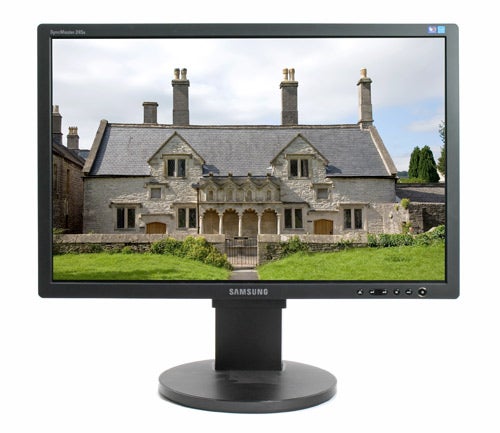
Verdict
Key Specifications
- Review Price: £345.99
It’s probably fair to say that Samsung has taken the monitor market by storm. Although the company always made pretty good monitors, even going back to the days of CRT, with its DynaFlat range, it’s in the past couple of years that Samsung has really started to pull ahead of the competition. Recently it seems that Samsung has something of a golden touch when it comes to monitors, marrying superb image quality with great design and reasonable pricing.
A good example of Samsung’s recent monitor prowess is the SyncMaster 215TW. This 21in widescreen display is such an impressive piece of kit, that none of the new generation of 22in displays have managed to dethrone it. In fact three of the guys in the office have actually put their hands in their pockets and bought a 215TW, even though it has never been what you might call a cheap option. 
I was therefore very curious when I heard about the Samsung SyncMaster 245B – a 24in widescreen monitor with a street price well below £400. Considering how impressed I was with Samsung’s high-end 24in screen, the SyncMaster 244T, I couldn’t help but wonder what compromises had been made to reach such an attractive price point. But before we start talking compromises, let’s look at what you are getting for your £346.
Like pretty much every other 24in monitor, the 245B sports a native resolution of 1,920 x 1,200, which is becoming a very desirable option for a number of reasons. The most obvious plus point of a 1,920 x 1,200 resolution is that it gives you a lot of desktop real estate and allows you to have several windows open at once. But another significant advantage to this resolution over the 1,680 x 1,050 resolution seen on 20, 21 and 22in widescreen monitors is the ability to display 1080p high definition content. 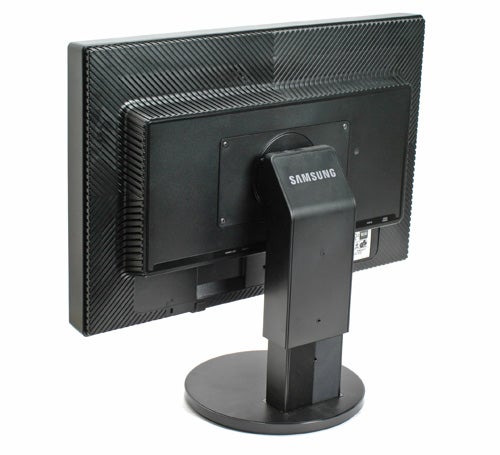
When it comes to 1080p video, a 1,680 x 1,050 resolution screen simply doesn’t have enough physical lines at its disposal, not to mention that the full HD standard resolution is 1,920 x 1,080. With that in mind, a 1,920 x 1,200 screen obviously has enough lines for a 1080p high definition signal, but having too many lines can also be an issue. Basically, for the best quality 1080p image on a 1,920 x 1,200 screen, you need 1:1 pixel mapping, which unfortunately the 245B doesn’t have. This means that if you plug in a device that’s outputting a 1080p signal it will be scaled to fit the full resolution of the screen, thus affecting the sharpness of the image and the overall aspect ratio.
The stand is pretty good, although you don’t get any pivot functionality – so if you like being able to switch into portrait mode, you’ll be slightly disappointed. A bit of investigation revealed that this monitor can actually pivot, but Samsung has disabled the function. The reason for this is that the viewing angle would be so poor if you pivoted the screen that it probably made more sense to take the option out of the equation completely. What you do get is nicely dampened height adjustment, tilt and a twist pad built into the base for easy left and right panning.
The bezel surrounding the screen is reasonably slim for a monitor this size at 16mm. There’s a Samsung logo in the centre below the panel, and the model designation at the top left – both are grey rather than white, so don’t spoil the sleek, black look of the 245B too much. At the bottom right are the monitor controls. There’s a large round power button that glows – you guessed it – blue. Next to this is an Auto button which will auto adjust the monitor if it’s connected to an analogue source – this button is inactive when connected digitally. The other four buttons are for Menu, Enter, Up and Down, primarily for navigating the OSD. Pressing the Up button when not in the OSD acts as a shortcut to the Brightness adjustment, while pressing the Down button acts as a shortcut to the MagicBright settings.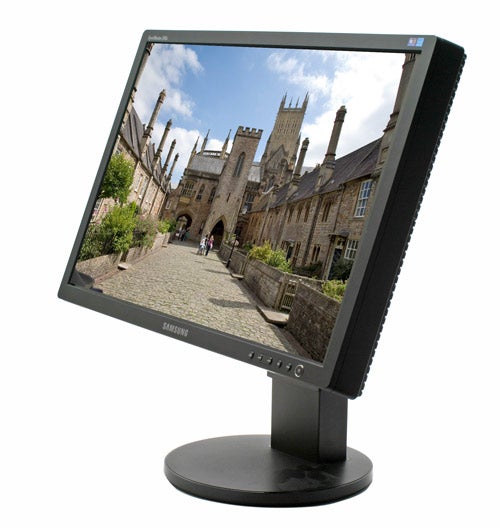
MagicBright comprises various preset states – Custom, Text, Internet, Game, Sport, Movie and Dynamic Contrast. I preferred to leave it set to Custom and make my own adjustment, since none of the presets were particularly pleasing to my eye. The Dynamic Contrast option refers to the dynamic backlight feature of the screen. Like many LCD TVs, the 245B can increase or decrease the backlight intensity depending on the subject matter on the screen. This ultimately improves black levels, and should put an end to blacks looking grey, as is often the case with LCD screens. However, while this is vitally important with large screen LCD TVs, I’m not sure how useful it is for a monitor. I guess if you watch a lot of video on your PC you might want to switch this feature on occasionally, but if you’re using it mainly for Windows work and even gaming, you’re better off switching the Dynamic Contrast feature off. Just for the record, this screen has a real contrast ratio of 1000:1, while the dynamic feature raises that to 3000:1. Meanwhile the 400cd/m2 brightness level is pretty respectable for a screen this size.
The real differentiating factor between the 245B and every other 24in widescreen monitor we’ve reviewed is the fact that it utilises a TN panel, rather than an S-PVA panel. The big advantage to TN panels is that they are far cheaper than S-PVA or S-IPS panels, but the downside is that the image quality and viewing angle are rarely worth shouting about. Unfortunately, the 245B doesn’t break the mould, and when it comes to image quality this screen is no match of pretty much any of the other 24in monitors we’ve reviewed.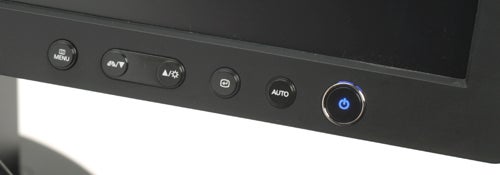
First up, the viewing angles can only be described as poor in both the vertical and horizontal planes. If I stand up while maintaining my view of the screen it becomes noticeably darker – it almost looks like a dark sheet is being drawn up over the image. Viewing from the side is slightly better, although there’s still a drop in brightness and discernable colour shift.
When it comes to image quality the 245B also struggles to compete with other 24in displays. There’s noticeable compression when viewing high resolution photos, and no amount of adjusting can trim it out. Colours also have a slightly over saturated look to them, which often results in a loss of detail. Surprisingly, the 245B didn’t appear to be well setup out of the box, which is unusual for a Samsung, but after some tweaking and adjustment, it provided a reasonable image for Windows work.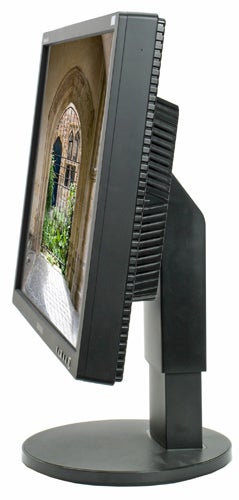
Firing up DisplayMate brought no surprises. The Dark Grey-Scale test faded to black far too quickly and no amount of adjusting could rectify this. Of course if you stood up or viewed it off plane, the intensity seemed to drop properly, but then all the greys looked green. At the opposite end, the Low Saturation Colours test showed that the 245B had problems at the high intensity end too, with the two percent bar completely lost in the white background. The Colour Tracking test once again highlighted strong hints of green and yellow in what should have been greyscale blocks. The Colour Scales also managed to trip the 245B up, with an uneven drop off at the low intensity, and a distinct drop in colour purity, also at the low intensity end.
Of course I never expected the 245B to excel at colour accuracy, seeing as it uses a 6-bit panel rather than an 8-bit one. This means that the 245B has a maximum colour palette of 16.2 million colours, but only through the use of dithering. Even then, a true 8-bit panel will give you 16.7 million real colours.
Where the 245B does work well is as a gaming screen – one thing that’s good about a TN panel is the fact that it can switch very quickly, with Samsung quoting a grey-to-grey response time of 5ms. Not that I feel response time is that much of an issue of course. Generally, anything with a 16ms off-on-off response time isn’t going to give you problems with moving images when gaming. All that said, the 245B makes a very competent gaming monitor, with no hint of motion smearing. Also, because you tend to remain in the “sweet spot” when playing a game, the colour and intensity shifts don’t rear their heads.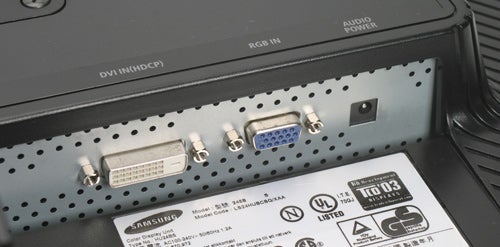
Video is watchable, but this screen is no match for even an average high definition TV. Black levels are pretty disappointing, even when you enable the dynamic backlight, with dark areas in scenes always looking more grey than black.
Input wise, you get an HDCP compliant DVI port and an analogue D-SUB, and that’s it. There’s no component video input, no HDMI and not even a USB hub. Also, the lack of 1:1 pixel mapping means that even the HDCP support on the DVI port isn’t that useful, since any high definition source you connect, such as an HD DVD player or PlayStation 3 will be scaled to the full resolution of the panel. 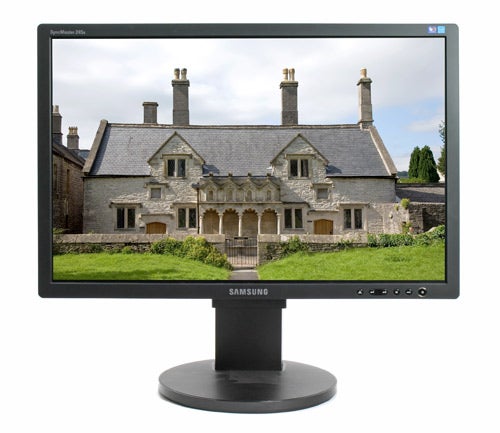
Despite the 245B’s shortcomings, it’s the price that will attract potential buyers, and at £346 including VAT, this is by far the cheapest 24in monitor we’ve seen. Of course a big part of that cost saving is due to the TN panel, and you’ve got to decide whether you’re willing to compromise image quality for the sake of cost.
”’Verdict”’
The Samsung SyncMaster 245B is definitely a value focussed 24in display, where hitting a price point was clearly the goal over offering great image quality. If you’re looking for a 1,920 x 1,200 monitor for gaming and you’re on a very tight budget, then this is definitely an attractive option.
Trusted Score
Score in detail
-
Image Quality 6
-
Value 10

